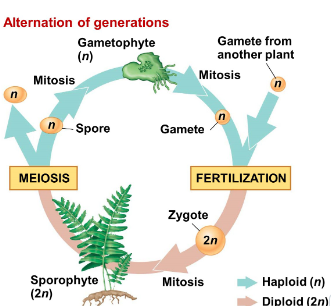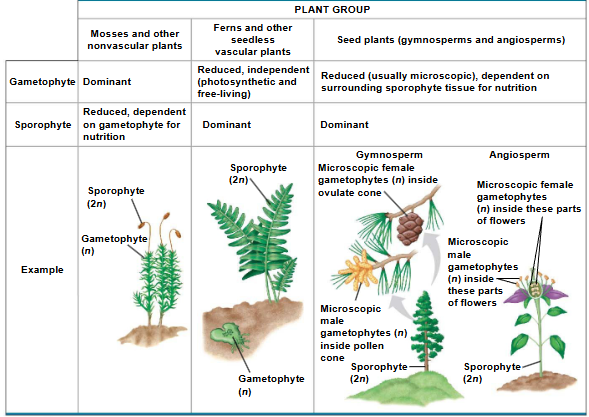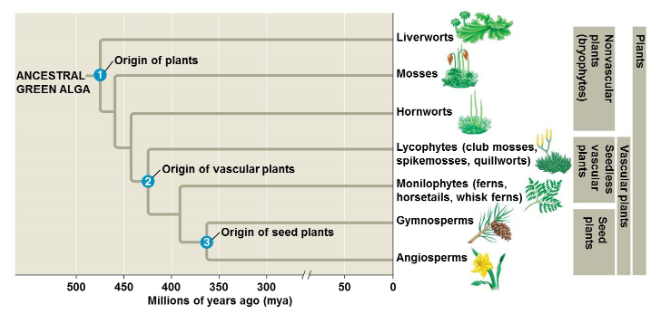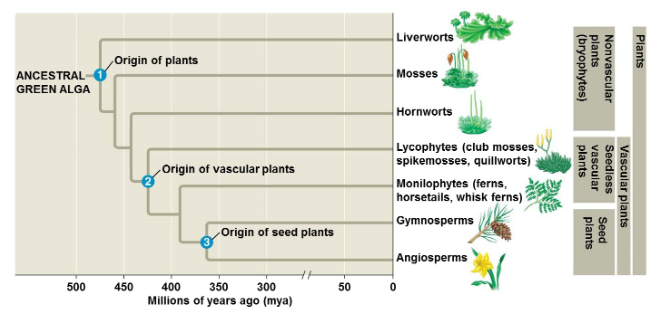Bio II Exam IV: Chapter 26 "The Colonization of Land"
1/67
There's no tags or description
Looks like no tags are added yet.
Name | Mastery | Learn | Test | Matching | Spaced |
|---|
No study sessions yet.
68 Terms
A multicellular embryo
Defining feature of a land plant (and not of algae or fungi) —- embryophytes
Sporopollenin
In charophytes, a layer of durable polymer called this prevents exposed zygotes from drying out. Also found in plant spore walls.
Gametophyte
This is part of the alternation of generations of plants — this is haploid and produces haploid gametes by mitosis.

Sporophyte
Fusion of gametes produced by gametophytes gives rise to this diploid, which produces haploid spores by meiosis

Sporangia
Multicellular organs that produce walled spores. The spore walls contain sporopollenin, which make them resistant to harsh environments
Embryophytes
Land plants are called this because of the dependency of the multicellular, diploid embryo on the parent
Apical Meristems
Localized regions of cell division at the tips of roots and shoots. They divide throughout the plants life
Cuticle
A waxy covering of the epidermis of a plant that functions in preventing water loss and microbial attack
Stomata
Specialized pores that allow the exchange of CO2 and O2 between the outside air and the plant
T
(T/F) The earliest land plants lacked true roots and leaves. Instead, they formed symbiotic associations with fungi to obtain nutrients
Fungi
Heterotrophs that absorb nutrients from outside their body. They consist of networks of branched hyphae, filaments adapted for absorption. They use enzymes to break down complex molecules into small organic compounds
Hyphae
Networks of filaments adapted for absorption that make up fungi
Nucleariids
Fungi are most likely related to unicellular protists called this
Choanoflagellates
Animals are most likely related to unicellular these
F
(T/F) Multicellularity arose together in animals and fungi
Chitin
Fungal cell walls are made up of this, a strong but flexible polysaccharide
Mycelia
Networks of branched hyphae, which are filaments used by fungi for absorption
Single
Yeast is a type of fungi that grows in a (single/mutli) cellular organizationcellular organization, consisting of individual cells that reproduce by budding.
Mycorrhizae
The relationship in which fungi exchange nutrients with the roots of a plant through specialized hyphae. The fungus improves the delivery of phosphate ions and other minerals to the plant, and the plant provides the fungal partner with organic nutrients such as carbohydrates
Arbuscular
(Arbuscular/Ecto) mycorrhizal fungi extend their hyphae through the cell wall of a plant’s roots and into tubes formed by the invagination of the root cell membrane
Ecto
(Arbuscular/Ecto) mycorrhizal fungi form sheaths of hyphae over the root and also grow into the extracellular spaces of the root cortex
T
Land plants can be informally grouped based on the presence of absence of vascular tissue (T/F)
Vascular
(Vascular/Bryophytes) plants have vascular tissue for the transport of water and nutrients
Bryophytes
(Vascular/Bryophytes) are non-vascular plants. Includes liverworts, mosses, and hornworts, and they are thought to be the earliest lineages diverged from the common ancestor of land plants. The gametophytes are the longest living form.
Rhizoids
These anchor bryophytes (non-vascular plants) to the substrate
F
The gametocytes of bryophytes are very tall due to lack of vascular tissue to support it
T
(T/F) Vascular tissue allows a plant ot grow very tall
T
(T/F) In contrast with bryophytes, sporophytes of seedless vascular plants are the larger generation. The gametophytes are tiny plants that grow on or below the soil surface
Lycophytes
One of two clades of seedless vascular plants; includes club mosses and their relatives.
Monilophytes
One of two clades of seedless vascular plants; includes ferns and their relatives
Acknowledged
Acknowledge the chart

Xylem
One of two types of vascular tissue in vascular plants; this conducts most of the water and minerals, and includes tube shaped cells called tracheids
Tracheids
Tube shaped cells in xylem that helps conduct water and minerals inside of a vascular plant
Lingin
Water conducting cells are strengthened by this, which provides structural support
Phloem
One of two types of vascular tissue in vascular plants; these are cells arranged in tubes that distribute sugars, amino acids, and other organic products
T
(T/F) Vascular tissue is an evolutionary advantage because it allows plants to grow taller, making them better competitors for sunlight and allowing spores to be dispersed more easily
Roots
This structure anchors vascular plants to the ground and enables them to absorb water and nutrients from the soil
Leaves
This structure increases the surface area of vascular plants, thereby capturing more solar energy used for photosynthesis
Microphyll
A type of leaf with a singular vein
Megaphyll
A type of leaf that is large and very productive, with a highly branched vascular system
Seed
This of a plant contains an embryo and its food supply, surrounding by a protective coat. They are dispersed by the wind, animals, or by other means. They are multicellular, have a stored food supply, and remain dormant until conditions are favorable for germination, providing an evolutionary advantage over spores. Develop in an ovule
Gynosperms
This type of seed plant has “naked” seeds that are not enclosed in chambers. For example, a pine cone. These are adapted to drier conditions due to seeds and pollen, thick cuticles, and leaves with small surface area
Angiosperm
This type of seed plant has seeds that develop inside chambers called ovaries. For example, an apple tree.
T
All seed plants have (T/F)
Reduced gametophytes
Ovules
Pollen
Ovule
This in a seed plant consists of an egg producing female gametophyte surrounded by a protective layer of tissue called integument. These female gametophytes develop from large megaspores. Develops a seed
Pollen grain
This in a seed plant consists of a male gametophyte enclosed in a protective pollen wall. These male gametophytes develop from small microspores
Pollination
The transfer of pollen to the part of a seed plant containing the ovules
Conifers
Cone bearing gymnosperms
Flower
An angiosperm structure specialized for sexual reproduction. Most of these are pollinated by insects or other animals, while some are wind-pollinated
Sepals
One of the four specialized leaves on a flower; These are leaves which enclose a flower (seen at the base)
Petals
One of the four specialized leaves on a flower; these are brightly colored and attract pollinators
Stamens
One of the four specialized leaves on a flower; these produce pollen
Carpels
One of the four specialized leaves on a flower; these produce ovules
Ovary
Contains one or more ovules
Pistil
Refers to a single carpel or two or more fused carpels in a flower
Fruit
The ovary wall of a flower thickens and matures to form this, which protect seeds and aid in their dispersal
F
The evolution of angiosperms is fully understood (T/F)
T
(T/F) The common ancestor of angiosperms and gymnosperms diverged about 305 million years ago.
Lichen
A symbiotic association between a photosynthetic microorganism and a fungus. Integral to the colonization of land by plants since they break down the soil surface, making it possible for them to take root.
Mutualism
A biotic relationship in which both species are benefited
Parasitism
A biotic relationship in which one species is benefited while the other is harmed
Endrophytes
Plants harbor these fungi in a harmless symbiotic relationship. These fungi live inside of leaves or other plant parts, and are sometimes toxic to defend against herbivores and toxins
T
(T/F) about 30% known fungi species are parasites or pathogens, mostly towards plants
Embryo
What trait evolved at the point labeled 1?

Vascular Tissue
What trait evolved at the point labeled 2?

F
(T/F) The flower petals of a flower produce gametes
Ovary
What part of a flower contains the female gametophyte?
fungi
Which group of organisms is thought to have significantly helped plants invade land?
algae
protists
fungi
insects
tetrapods